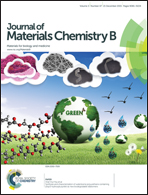The preparation, drug loading and in vitro NIR photothermal-controlled release behavior of raspberry-like hollow polypyrrole microspheres†
Abstract
The combination of NIR photothermal therapy and chemotherapy is considered as the promising technique for future cancer therapy. The key point of this technique is the design and synthesis of photothermal agents with high-efficiency photothermal effects and high chemical drug loading capacity. Herein, submicron-sized raspberry-like hollow-structured polypyrrole microspheres (H-PPy) were facilely prepared through in situ polymerization of pyrrole on monodispersed polystyrene (PS) template microspheres with a diameter of 220 nm, followed by the chemical etching of PS templates. The prepared H-PPy microspheres show rapid and remarkable photothermal effects in water under NIR laser irradiation (808 nm) only for 5 min. Further, a model small molecular drug, (S)-(+)-camptothecin (CPT), was loaded into the void core by a simple dispersion–permeation process through the micro-pores on the raspberry-like PPy shell, with a loading capacity of 0.14 mg/(mg H-PPy). The MTT assay and the in vitro NIR-laser triggered release behavior indicated that pure H-PPy microspheres have good biosafety, but the release of loaded CPT into H-PPy microspheres can be achieved with remarkable spatial/temporal resolution after NIR laser irradiation, which results in excellent synergistic effect of photothermal and chemical ablation on HeLa cells, as proved by fluorescence microscopy. This work provides convenient synthesis of a promising cancer therapy agent with high drug-loading capacity and efficient NIR light photothermal effects, which can perfectly achieve the synergistic NIR photothermal therapy and chemotherapy of PPy microspheres.


 Please wait while we load your content...
Please wait while we load your content...